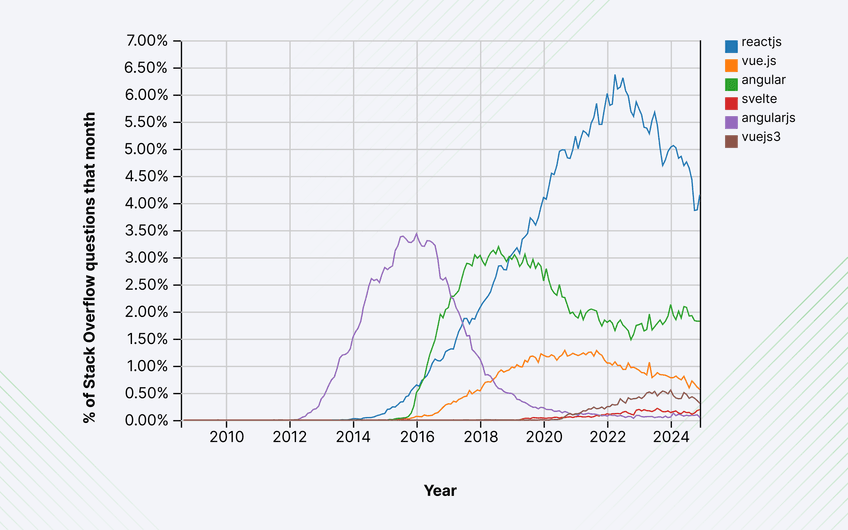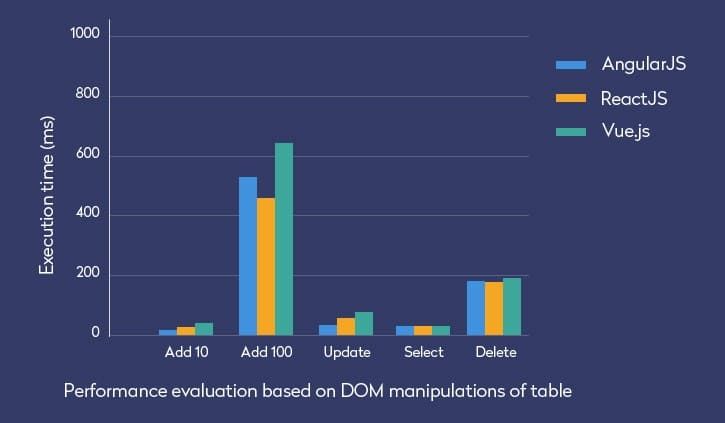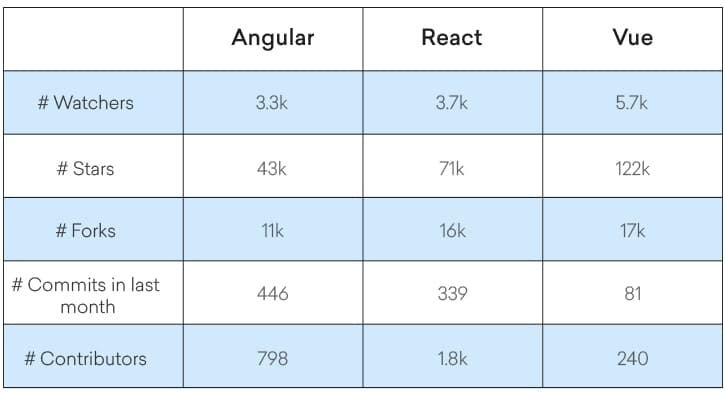JavaScript continues to be a top choice for businesses due to its flexibility in both client-side and server-side development, powering mobile and desktop applications.
For companies deciding on the right JavaScript framework, the options can be overwhelming. Angular, React, and Vue are among the top choices, each offering unique advantages for different business needs.
In this blog, we’ll break down these frameworks and provide a clear comparison to help you choose the best solution for your business, ensuring optimal performance and growth.
Angular vs React vs Vue: History
Angular:
Angular is a JavaScript framework based on typescript which was released by Google in 2010. Angular is the oldest framework among the three as it released before React and Vue. Until 2016, Angular was called AngularJS. But after the release of Angular 2+, the suffix JS was dropped.
Angular 19.0.6 is its latest version which was released on January 8, 2025. Wix and Google are two of the many other companies using Angular.
React
React was released by Facebook in the year 2013 as a tool to combat the issues caused by high traffic gained by Facebook ads. Moreover, it also solved coding and maintenance issues. Nowadays, React is used in high traffic websites. It’s also known to render top-notch support in building interactive user interfaces.
Its latest version – React 19.0.0, was released on 25 April 2024. BBC, Glassdoor, WhatsApp, PayPal, and Instagram are few of the popular companies that use React.
Read More: Why you must choose ReactJS for your next project.
Vue.js
Vue was released in 2014 and unlike Angular and React, no big name developed it. In fact, it was the brainchild of Google’s ex engineer – Evan You. The latest version of Vue – V3.5.13 was released on 11 October, 2024.
Since its inception, Vue is constantly gaining popularity among the developers. Vue is the newest member to the JavaScript Framework family. It has played a significant role in offering ease to the Vue.js developers for hire by eliminating all the drawbacks of other frameworks.
Websites like Alibaba and GitLab uses Vue.
Angular vs React vs Vue.js: Popularity
To evaluate the popularity of all the three frameworks, we will take various stats under consideration. The first one is the stack overflow statistics.
Stack overflow statistics
The stack overflow survey points out that React is the most preferred framework followed by the Vue.js.

The popularity of Vue.js has grown tremendously since its launch in 2014. However, a major boost occurred in mid-2016 which has sustained till now. In coming years, Vue is expected to rise even higher.
Angular vs React vs Vue.js: Performance
To find out which is the best JavaScript framework performance-wise, you can take memory consumption based on DOM manipulation as the key factors to determine the performance. In this test, the benchmark tool measures time consumed for total number of DOM manipulation events completed by using these frameworks. Let’s know more about the DOM manipulations.
DOM manipulations include benchmarking study which is based on studying these framework’s performances on the manipulation of rows of table. Manipulations done on the row mentioned as below:
- Add 10 rows to the table
- Add 1000 rows to the table
- Update every 10th row of the table
- Select a row from the table
- Delete a row from the table.

To show the memory evaluation of Angular vs Vue vs React, the study uses Chrome profiler to take snapshots of the JavaScript web pages.
Below two snapshots were taken for the demonstration of the memory usage at the time:
- When loading of page takes place before any action is performed.
- After performing the actions – 5 Add 1000, 5 Add 10, and 5 Update actions
Below are the results of the study:

Angular
Performance
Angular performs well with smaller DOM updates that consumes less than 50ms. Moreover, it seems to perform better than Vue and React when it comes to adding of 10 metrics. However, it shows comparable performance with Vue and React when it comes to the task of updating every 10th row along with selecting a new row from the table.
Memory consumption
As shown in the figure, when the webpage is loaded, the Angular’s initial memory footprint is 8.7 MB. However, once it performs the DOM manipulation operations, the footprints jump to 15.4.
React
Performance
The above figure shows that React’s virtual DOM performs well when the DOM updates gets bigger and there’s more data which needs to be updated. This aptly showcases the performance issues in React. Although React performs at its best at both Add 1000 metrics and Delete.
Memory consumption
Memory footprint of React follows a similar path to that of Angular. It reads 8.3 MB of memory consumption at the initial stage and 15.1 MB after the completion of the DOM operations.
Vue.js
Performance
Coming to the Vue’s performance, they are as good as that of React in cases like Update, select metrics, and Add 10. The only difference is that Vue struggles to match up React when it comes to Add 1000 metrics. This difference in performance is due to the increase in the number of DOM manipulations.
Memory consumption
Talking about Vue, its memory footprint at the initial state marks at 7.6. This reading is way better than that of React and Angular. However, once the DOM manipulations operations are completed, the value skyrockets to 16.1, which is way more than that of React and Angular.
Angular vs React vs Vue: Top use cases
All the top-notch companies use JavaScript for the development of their product. All the top software development services are heavily utilizing these three best JavaScript frameworks. Companies like Facebook and Google also use these frameworks and libraries.
Let’s list down some of the big names using Angular vs React vs Vue:
Angular
Angular was developed by Google and now it utilizes Angular in Google AdWords applications.
The Guardian – A leading publishing sector firm
Weather.com – Leading website for weather forecast
React
Facebook developed React for maintenance and coding its ad campaigns.
Twitter – A global micro-blogging site
WhatsApp – The most popular messaging app
Instagram – A photo-sharing social media platform
Vue.js
9Gag – Social networking site for sharing trending videos, memes, and vines
GitLab – A repository manager that enables a team to duplicate or develop code.
Angular vs React vs Vue: Community support
After knowing about the history and trends of each framework. Let’s assess the development of each framework by having a look at their community.
Angular
Being introduced and utilized by Google for AdWords application adds to the authenticity of Angular. That's why when you hire Angular developers they get a robust community support since its inception. Angular gets its updates and releases quite regularly. It gets a major update every six month.
React
As mentioned earlier, React was developed by Facebook to support its ad campaigns. There’s still a dedicated team of engineers at Facebook which is working its improvement. Facebook has heavily invested in React since they have coded many of their product to React. This is one of the major reasons why React’s reliability is rapidly growing among the developers.
Vue.js
Unlike Angular and React, Vue is not a product of any top-notch corporate. You might think that this might have caused a huge setback to its popularity. However, it’s completely the opposite in reality. This JavaScript framework has earned tremendous popularity due to its open source community.
Let’s have a glimpse at the Angular vs React vs Vue stats on their GitHub repositories.

The huge number of watchers, stars, and forks is the testimony of Vue’s popularity among the developers as compared to that of Angular and React. However, the number of contributors and commits considerably drops against that of Angular and React.
One possible explanation to this is the fact that Vue is totally open source community; whereas, Angular and React already have a massive share of Google and Facebook employees contributing to its repositories respectively.
Angular vs React vs Vue.js: Framework size
Talking about the size, Vue is lightest among the three. On the other hand, Angular is suitable for heavy-weight application. Vue and React are most suited for the light-weighted applications.
Angular
Angular offers many things from templates to testing utilities to its developers. Thus, it requires more space which eventually makes it big in size and unsuitable for light-weight applications.
React
React is suitable for light-weight applications as it doesn’t have much to offer like Angular. React is a quite different from Angular and thus requires support from other libraries for routing and other tasks. It is better to hire React developers in case of complex app development to avoid any errors or confusion in the future.
Vue.js
Vue is smallest among all three frameworks. That’s why it’s extremely suitable for lightweight application development. In case, you need a library that smaller than Vue, then you can go for Preact.
The sizes of the library are mentioned below:
Angular: – 500+ KB
React: – 100 KB
Vue: – 80 KB
Angular vs React vs Vue.js: Learning curve
Learning curve can be simply defined as the ability of users to write codes in particular programming language. Now let’s compare learning curves of each framework.
Vue.js: The easiest learning curve
Vue.js has the easiest learning curve among the three. It’s because it’s closest to the JavaScript basics and HTML. The initial stages of getting started with Vue.js are as simple as adding an import to the HTML. However, it does get complicated as you build more and more complex apps. For this, you need to work with. vue files which requires a complex project setup.
Angular: The steepest learning curve
Angular has the steepest learning curve since it uses TypeScript which is a subset of JavaScript. However, the syntax, components, and modules used in it can look quite different from what you’re used to. Angular consists of powerful features which makes developers to use certain coding pattern that helps them in building applications.
Read more: Testing Angular apps: A complete guide for developers
React: Medium learning curve
The learning curve of React.js comes in between that of Angular and Vue, that is, it has a medium to steep learning curve. It does have an “everything is JavaScript” approach. However, it comes with two important elements which makes it learning curve steeper. The first that it works best with the ES6 syntax, which is arguably a challenging thing for a beginner developer.
Second, is that it uses JSX syntax, which is a hybrid of JavaScript and HTML. Using JSX can be difficult and confusing since it looks like HTML but is still JavaScript.
Angular vs React vs Vue: Scalability
Scalability here means the ability of the solution to deal with a huge number of requests at a time. It’s important to note the behavior at the sudden peak of loads.
Angular
Angular comes with the concept of feature modules. This allows the developers in organizing related components with their dependencies (product module with a product card, product search page, product services, etc.). You can store a module in a separate repository. You can also reference it from your main application.
React
React can simply be referred as the library which is used for creating reusable components on a page. However, you would require to gather a bunch of many other libraries that can bring it all together.
Talking about scalability, it all comes down to the fact that how well the code is organized. Other factors like the amount of technical debt and the architecture of the solution also plays a significant part.
Vue.js
As discussed earlier, Vue is a lightweight JavaScript library, so it’s only suitable for smaller applications. It’s not suitable for building scalable applications.
Conclusion
The comparison above should give you clarity on choosing the right JavaScript framework. If you're building a large application, Angular is a solid choice, especially if you're comfortable with TypeScript. For projects involving large teams, React is a strong option. If you’re open to exploring something modern and lightweight, Vue.js is worth considering.
Beyond selecting a framework, having the right developers is crucial. Partnering with an experienced software development company can help you get a tailored solution that meets your business needs.
This is where Peerbits comes in. Our team of dedicated developers for hire hold deep expertise in Angular, React, and Vue.js. Join us for robust and customized software development solutions.









